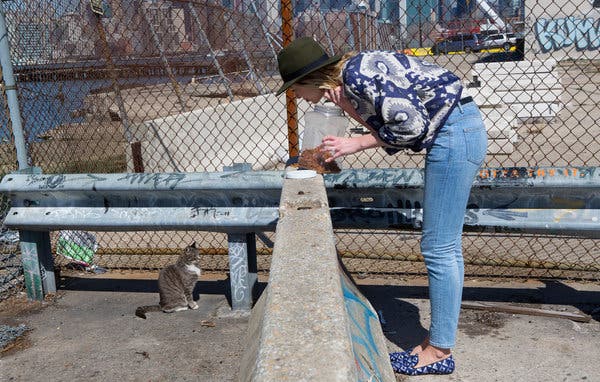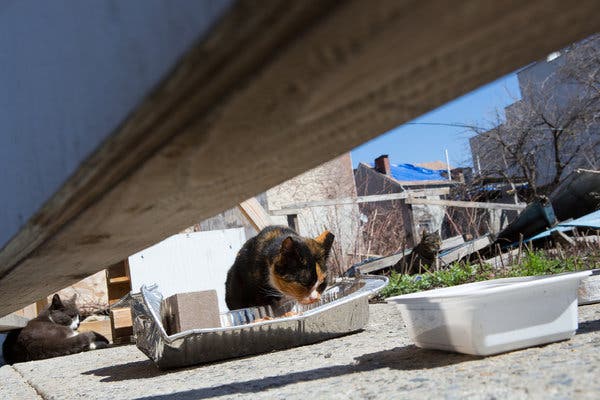It was nearly 3 a.m. and her target still had not fallen for the trap. Stephanie Seiler was sitting in a 22-year-old pickup truck on a Brooklyn street. She knew he would be back, so she opened a bottle of wine and settled in to the 12th hour of her stakeout.
Several hours later, a clash of metal sprung her to attention. She leapt out of the truck and came face-to-face with her elusive prey — Tom Waits, a surly feral tomcat.
He was caught in a drop trap and was not happy: The cat rattled his confines like a “bronco” until Ms. Seiler, 39, quieted him by covering the cage with a blanket. She then carted him away.
He was back on the streets in a few weeks, freshly neutered and with several shots from a veterinarian.
Ms. Seiler is part of an army of over 5,500 volunteers mobilized to take on one of New York’s more intractable challenges — the tens of thousands of stray and feral cats that roam alleys, empty lots and other hidden corners of the city. While the cats help keep the vermin population in check, they can also carry disease, kill backyard wildlife and be noisy nuisances when they are seeking a mate.
In the past the city tended to deal with free-roaming cats by starting periodic roundups and taking cats to shelters to be adopted or, more likely, euthanized. But that did not make much of a dent in the population, according to animal advocates.
“If you see 20 cats, there are probably 40,” said Becky Robinson, president of Alley Cat Allies, a national advocacy group. Any cats that escaped a sweep “would just breed back up to capacity like any other life form,” she said, adding that “the reproductive capabilities of this species should not be underestimated.”

Credit…Ruth Fremson/The New York Times
But three years ago the city shifted to a new approach to control stray cats that relies on volunteers trained to trap, neuter and then return them to their colonies in the neighborhoods they came from. Volunteers care for the cats, providing them food and water. Advocates say the tactic is contributing to a decrease in the number of stray cats in the city. The new strategy is gaining popularity across the country, and in New York training classes fill up quickly.
Keeping the population of stray cats in check requires a systematic approach, animal advocates say: To ensure that every cat in a colony has been sterilized, caretakers get to know their wards so that they can better monitor the size of the population. Under their watchful gaze, any new cats who wander in can be separated and taken to a veterinarian. The cats have the top of their left ears clipped as a sign that they have been neutered.
Not all cats are as hard to trap as Tom Waits, who earned his name because his rough exterior recalled the gruffness of the singer’s voice. Usually, caretakers withhold food for a few days before luring hungry cats into baited cages with drop doors.
When she moved to Bushwick, Brooklyn, last August, Myra McMinn, 32, noticed several cats that would meander through her backyard, so she put cat food out from time to time. And then they multiplied.
All of a sudden, she said, “The seven cats had had nine kittens, and I did not know what to do.”
She sought answers online and found a group called Neighborhood Cats that offers workshops in trap, neuter and return. After attending a three-hour class, Ms. McMinn took a week off from a temporary job she has while getting a master’s degree at Columbia. She borrowed 19 cages and set about luring the cats with Fancy Feast. (The shyer ones required sardines.) With the help of a handful of volunteers, she caught 12 the first night.
“It was like camping and being a new mom,” Ms. McMinn said of the long night before the American Society for the Prevention of Cruelty to Animals showed up to take the cats to be neutered. “All the cats would yowl if one of the other ones pooped, so I was waking up every 10 to 30 minutes.”
The newly neutered felines were all returned to her; she had to let them recover for a few days in her room before they could go back outside. Now the cats come and go from the backyard but without any new kittens in tow.
But as trap, neuter and return has gained in popularity, a backlash has emerged. Some critics argue that the tactic fails to significantly decrease the number of stray cats, in part because many owners do not neuter their pets and then have nowhere to house kittens, leading to more cats on the street. And across the country, bird watchers and birding groups say feral cats have decimated the population of backyard birds.

Credit…Ruth Fremson/The New York Times
“Outdoor cats obliterate wildlife,” said Robert Johns of the American Bird Conservancy, “and yet they get special treatment. We don’t allow colonies of feral dogs to roam around.”
Animal advocates argue that feral cats often have no place to go. “True ferals, by definition, are not adoptable because they are not socialized to people,” said Susan Richmond, a founder and the director of Neighborhood Cats.
There are no reliable estimates about the total number of stray cats in New York. But Neighborhood Cats, which keeps a database of more than 2,000 stray cat colonies, says that cat populations have gone down in well-managed colonies, helping to alleviate the population over all.
Advocates also point to greatly reduced numbers of cats taken to shelters for adoption or euthanasia as a sign of success. Intakes fell 35 percent, to 18,219 in 2013 from 27,940 in 2009, according to Animal Care and Control of NYC, a nonprofit organization that has a contract with the city to take in rescued animals. Euthanasia numbers (excluding requests from owners) fell 63 percent, to 3,044 in 2013 from 8,122 in 2009.
Chris Glazier, 41, and Jeannie Purvis, 44, have filled their Bushwick home with former street cats and foster friendly strays that are up for adoption at local pet stores. They became involved with the practice of trap, neuter and return when a pregnant stray cat started showing up in their backyard and had kittens.
“There were five other cats, too,” Mr. Glazier said. “We knew that if we didn’t do something, it was going to get a lot worse.”
Now they host a colony of 12 neutered cats, give or take a few, in the backyard. They live in shelters built from Rubbermaid containers stuffed with straw and are fed a couple times a day. “They are spoiled,” Mr. Glazier said.
Ashley Shaw, 28, is one of three caretakers of a colony in Greenpoint, Brooklyn, whose home is in a vacant lot enclosed by a plywood fence. Feeding the cats means pushing food under the slats of wood. And unlike Mr. Glazier and Ms. Purvis, who can change the straw in the cats’ beds and keep their backyard clean, Ms. Shaw does not have much control over the cats’ living situation or location.
“It’s like the Wild West in there,” she said. She worried about them during Hurricane Sandy and is concerned about their fate when the lot is eventually developed. “But they are such fighters, they are really so strong,” she said.








